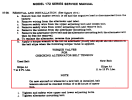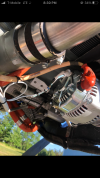I fly a PA-24-260. My voltage regulator is 3yrs old(Zeftronics), my battery is 2yrs old(Concord), and my alternator is 1yr old(plane power). On two out of the last several flights while flying in hard IMC and heavy rain, the amps on my alternator dropped and the load shifted to the battery for about 2-3 seconds and then everything went back to the alternator. At the same time the volts dropped to 13.1-13.6V, when they normally sit at 14.1-14.2. All of this has been seen and recorded on my CGR30C. In total, this has happened 3 times in the last 12 or so hours of flying and only in hard IMC with rain. Several folks I’ve contacted have said it could be a slipping alternator belt. I checked it the other day and while it seems a little loose per the Lycoming deflection test, it doesn’t seem that loose. Others think that water is entering and negatively affecting the alternator. This may be, but it seems like this would be a more common issue based on where alot of alternators sit. I’ve checked the connections on the VR and alternator and nothing is loose. Has anyone experienced anything like this? Any ideas where to focus?
You are using an out of date browser. It may not display this or other websites correctly.
You should upgrade or use an alternative browser.
You should upgrade or use an alternative browser.
Alternator Charging Issue
- Thread starter PA2407P
- Start date
The regulator will interrupt the field circuit if it detects an over voltage. It usually tries to reset when the over voltage is no longer present. Could be a bad ground somewhere that causes a voltage rise on one circuit then when the regulator tries again the amp draw connects the ground again.
What do you mean by "the amps on my alternator dropped"? The entire load dropped off?Any ideas where to focus?
My guess would be water getting in somewhere since only in rain and self-recovers.
- Joined
- Dec 5, 2010
- Messages
- 5,157
- Display Name
Display name:
GeorgeC

I had a flickering ALT INOP light that turned out to be a loose field wire; it's easy to imagine a similar scenario with water ingress intermittently grounding something that shouldn't be grounded.
What do you mean by "the amps on my alternator dropped"? The entire load dropped off?
My guess would be water getting in somewhere since only in rain and self-recovers.
What I meant was that the current load on the alternator dropped as the load on the battery increased. The load was split between the two.What do you mean by "the amps on my alternator dropped"? The entire load dropped off?
My guess would be water getting in somewhere since only in rain and self-recovers.
Skip Miller
Final Approach
Alternator belts should be hella tight. Tighten yours to spec and I bet your problem goes away. -Skip
Vance Breese
Cleared for Takeoff
On my alternator belt (IO-320 and Plane Power) the failure mode is to chuck parts off the inside. To inspect it properly I have to rotate the engine so I can inspect every part of it. The outside looks fine. When it begins to fail my volt meter goes up and down.
Domenick
Pattern Altitude
- Joined
- Sep 11, 2019
- Messages
- 1,831
- Display Name
Display name:
Domenick
Field wires tend to be thin and vibrate hellaciously. Check the connector and ensure the conductors are not broken in the sheath. I've seen it happen. The wire looks good from the outside, but the internal conductors have work hardened and broken. Intermittent contact and increased resistance randomly affects alternator performance.
So I take it you have an ammeter installed and it hows the amp reading move from a positive value to a negative value?What I meant was that the current load on the alternator dropped as the load on the battery increased. The load was split between the two.
Does this 2-3 second change happen at the same sequence during flight like when you select the flaps or other equipment?
Dan Thomas
Touchdown! Greaser!
- Joined
- Jun 16, 2008
- Messages
- 10,777
- Display Name
Display name:
Dan Thomas
Actually, the spec, in Cessna manuals, is a torque reading on the pulley nut while holding the prop still. The belt is not supposed to slip at torques up to the spec. And that belt is not terribly tight at that setting. I've done it numerous times. Belts that are overtight will cause mounting bracketry cracks and failures, belt failures, and alternator bearing failures.Alternator belts should be hella tight. Tighten yours to spec and I bet your problem goes away. -Skip
A 60-amp alternator at 14 volts is producing 840 watts, a bit over one HP. The belt's work would be somewhat more than that due to the alternators less-than-100% efficiency, but it's not a big load for an automotive V-belt that was often found driving the fan and water pump, the alternator, the power steering, and airconditioning compressor.

I want to know how many hours it's been since the OP's alternator was off for a brush inspection. If they're just about shot, a bit of water on the slip rings might offer enough resistance to interrupt the field current flow into the rotor, and the output is gone.
Dan Thomas
Touchdown! Greaser!
- Joined
- Jun 16, 2008
- Messages
- 10,777
- Display Name
Display name:
Dan Thomas
One more: Is there any oil leak near the front of the engine? A slightly oily belt will get sticky, but when it gets wet it gets really slick and will slip.

